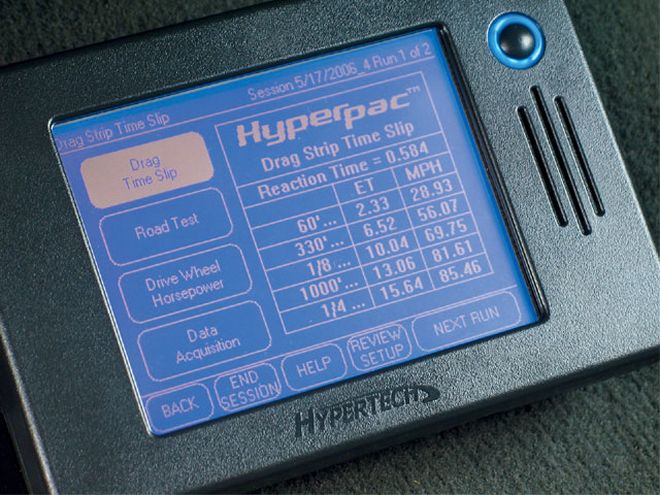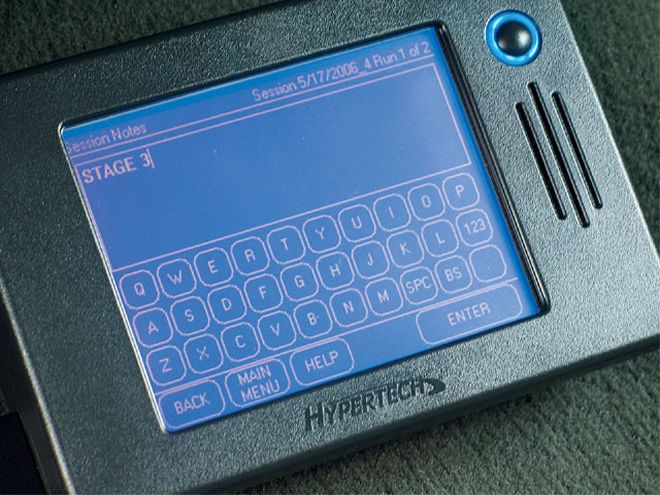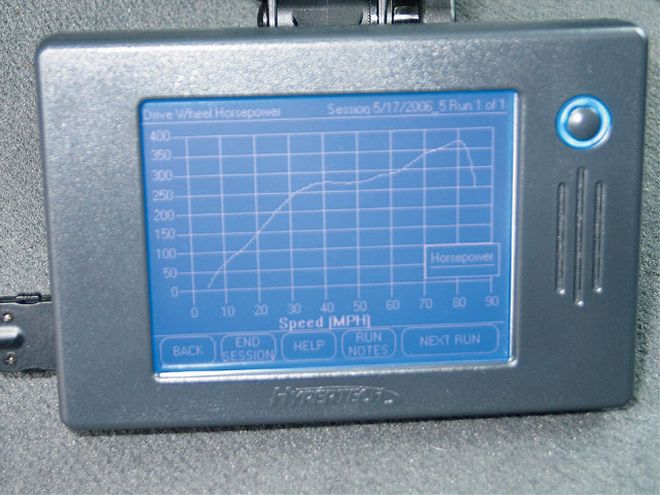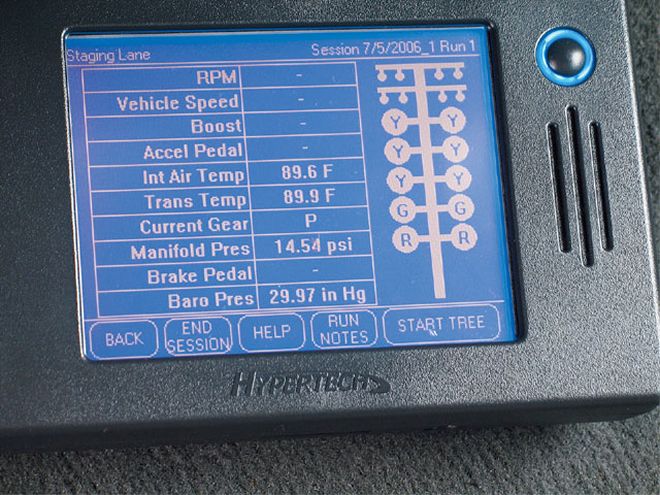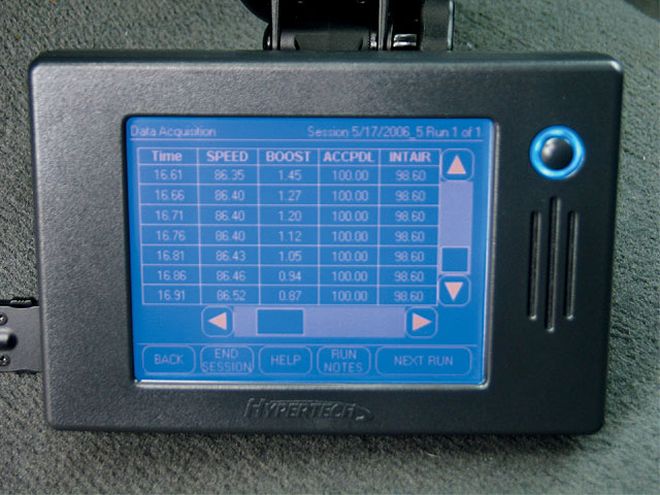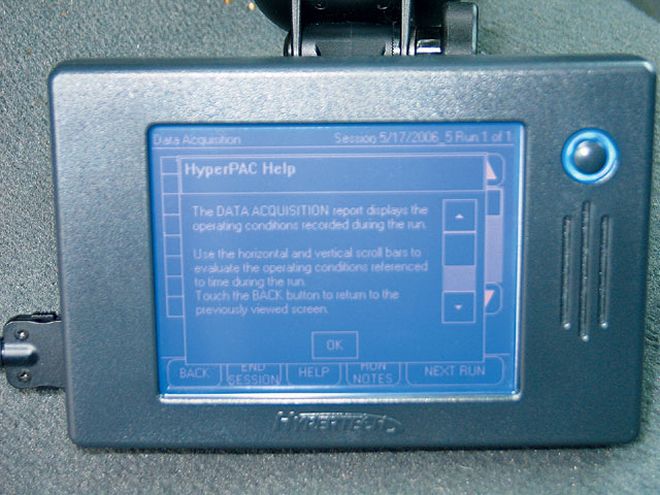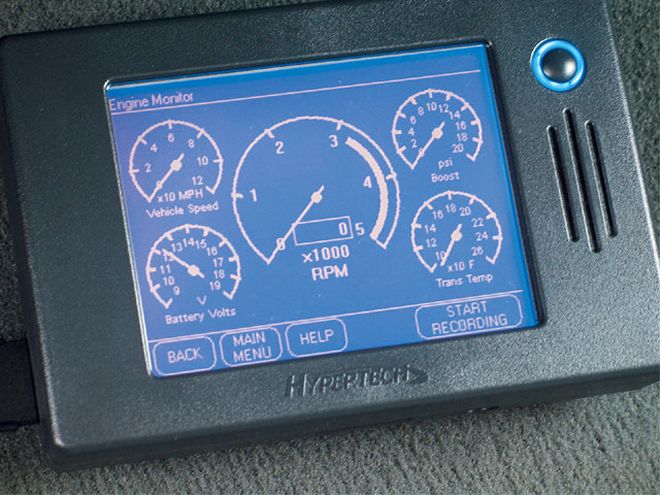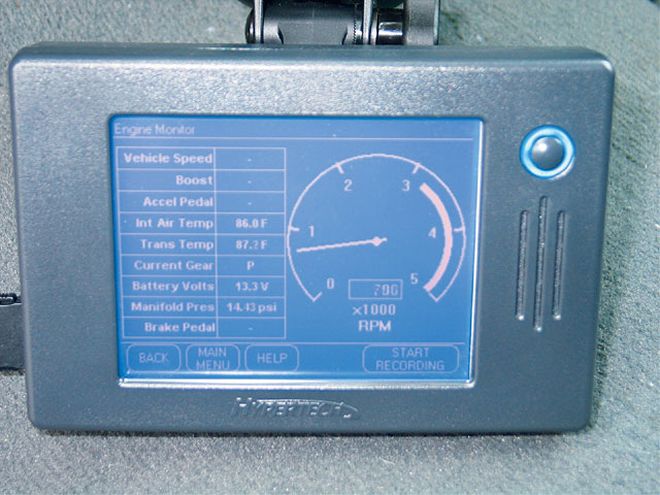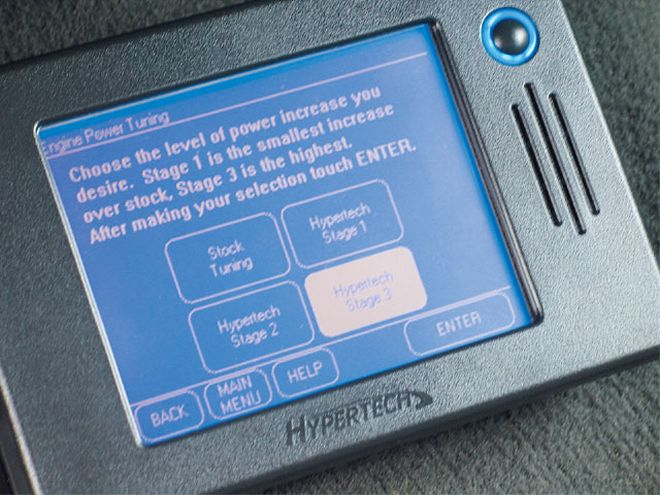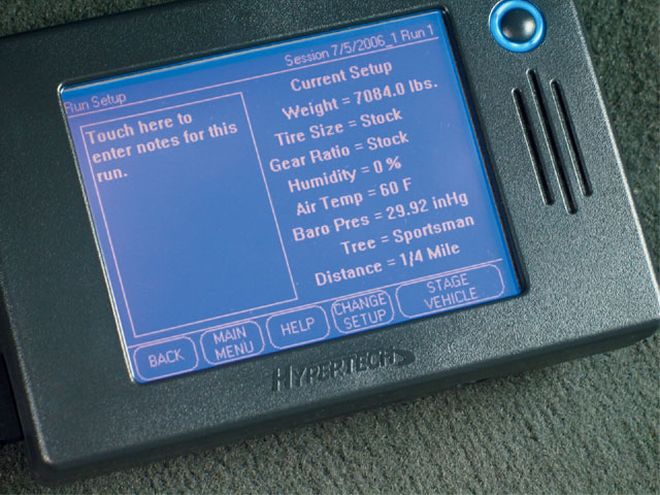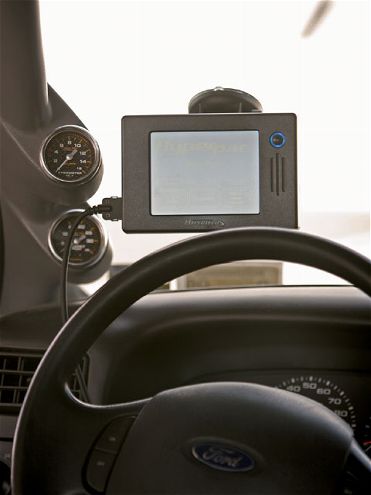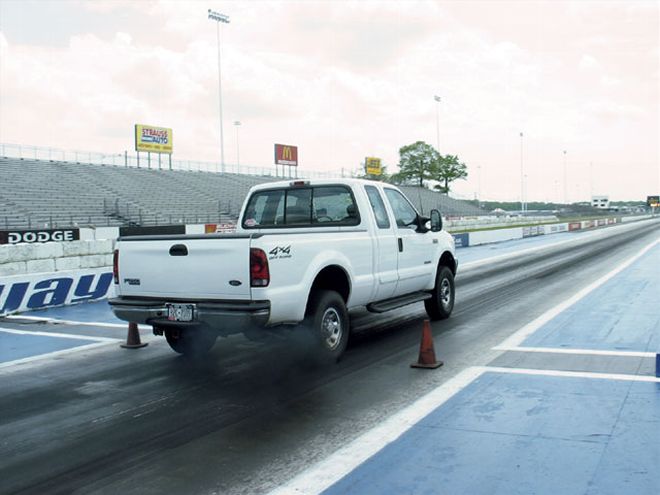
| hypertech Hyperpac leaving The Starting Line
Technology has been moving at an extremely quick pace over the past decade or so, and the rapid movement has brought an abundance of computers with features that some never thought possible.
We've faced a similar technological advancement in the truck market. Once we shed the carburetor-induction systems, we went to computer-controlled fuel injection. Early fuel-injected hot rodders relied on replacement computer chips to add a little more power to their combination. Those simple computer chips were followed with more-advanced replacement chips that manipulated more than just timing and fuel curves. As the computers became more complicated from the factory, so did the ways of cracking the coding and manipulating it. Soon, custom tuning was available and the tuner would burn a chip and replace the factory one.
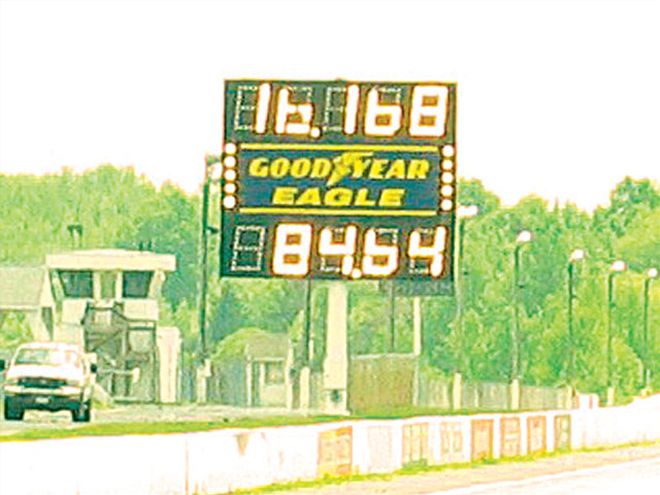
| hypertech Hyperpac pass After Tune
Our '02 F-250 Super Duty leaves the starting line at Englishtown Raceway Park. By the end of the day, we had loaded the Stage 3 tuneup and knocked down low 16-second performances. Our best was 16.16 at 84.64 mph, far better than the 17.99 at 76.02-mph run we turned during baseline testing.
Times moved forward, and aftermarket computer chips are now becoming less popular. The leading method of uploading a computer tune is through the OBD-II port, which is a computer-diagnostic access point. By way of a port under the dashboard, handheld tuners plug into '96-and-later vehicles and electronically extract the factory engine parameters and replace them with a modified set of commands. That may be a much-shortened history, but you can see how tuning our trucks has evolved over the past 10 years. Just like the personal-computer industry, our methods and tools have improved by becoming smaller and more advanced. That stacks up to a superior product for you, the consumer.
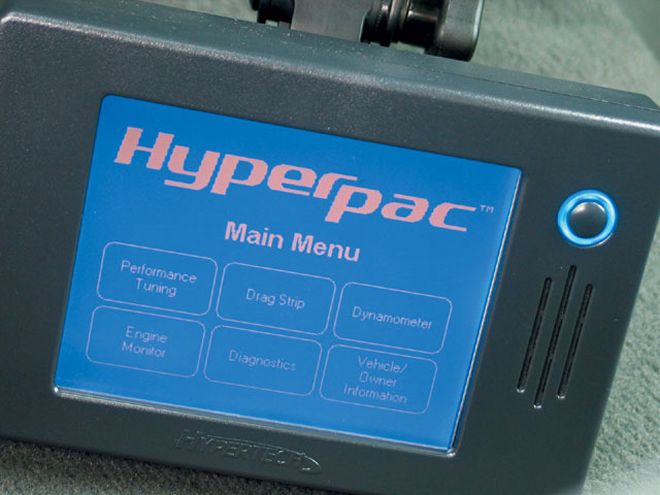
| hypertech Hyperpac hyperpac
After the initial vehicle setup, the Hyperpac's main menu appears. This is where you'll navigate through the five different functions the Hyperpac offers. The main menu is a touch screen, making it easy to use. It also offers the option to go back into the vehicle/owner information. This is so further modifications can be made to the vehicle's details like rear-gear and tire-size changes.
Taking the handheld-programmer market to the next level is Hypertech, a longtime staple in the industry. The company was born in the early 1980s and quickly made its mark with replacement PROM (or chips) for ECMs. The latest product from the Hypertech folks is its highly touted Hyperpac ("pac" refers to Performance Automotive Computer). We first learned of this computer tuner at last year's SEMA Show. This past spring, we were able to get our greasy hands on one for some testing.
The Hyperpac is unique in that it's more than just a tuner. There are five distinctive features included: performance tuning, dragstrip, dynamometer, engine monitor, and diagnostics. Like we said, this programmer is more than a tuner. Hypertech even hints that there are more options coming; the Hyperpac can be upgraded with these new features once they are available. Like the modern computer tuners, this one plugs into the OBD-II located under the dashboard.
The Hyperpac is available for 6.0L and 7.3L Power Stroke-equipped trucks (including Excursion). In this issue we installed the Hyperpac on an '02 F-250 Super Duty with a 7.3L Power Stroke. The only modifications to the truck were a K&N cold-air kit and a MagnaFlow exhaust system (with stock downpipe).
When you open the box, the Hyperpac looks more like a navigational unit rather than a high-performance tuner. The instructions can be intimidating since the manual is 66-pages thick. We don't follow instructions all that well, so we decided to learn as we went. The Hyperpac was plugged in under the dashboard, and we navigated through the screens using the instruction booklet as a guide. There are a series of setup questions to answer so the computer can adapt to the truck and accurately monitor and log dragstrip performance, run diagnostics, and calculate estimated horsepower.
With the truck's data in the system, we then proceeded to the dragstrip section of the Hyperpac. All testing was conducted at Englishtown Raceway Park on its quarter-mile track. The Hyperpac measures quarter-mile elapsed times and speeds, thanks to an internal mechanism.
After making several baseline runs, it was quite apparent that the Hyperpac read a bit quicker than the E-town timing system. The difference in its performance is simple to explain. The Hyperpac starts recording quarter-mile action the moment the truck starts moving. The track's timing equipment starts recording when the front tires move out of the beam. There is a moment when the truck starts moving that the tires are still in the staging beams. The time it takes the tire to move out of the beams and activate the timing equipment is called rollout. In our testing, the Hyperpac started recording before the track timing equipment turned on. Hyperpac didn't account for rollout and therefore didn't produce the same performance results.
Hypertech engineers, recognizing that not all tracks are created equal, allowed for the Hyperpac to be calibrated for a particular track and rollout of a vehicle. We didn't know about that option until we were done, so we couldn't put it to the test. It pays to read the instructions first.
To say the Hyperpac is packed full of features is an understatement. It's capable of recording all sensors hooked up to the factory computer system as well as providing acceleration times from zero to your maximum speed. It reads in 10 mph increments, drive-wheel horsepower is calculated every 10 mph, and a graph is made at the touch of a button. Hyperpac has the ability to save sessions for future reference and provides space to jot down notes about the dragstrip pass.
We started with a baseline using the factory ECM tuneup and then moved on to the Performance Tuning section. Hypertech provides Stage 1, Stage 2, and Stage 3 programs. All stages are designed with the vehicle's maximum towing capacity in mind. Obviously, each stage is more powerful than the previous one, however, if that isn't enough, the user can tweak up to 10 variables to get even more performance out of the vehicle. If you jumped the rear-gear ratio or tire size, the Hyperpac can adjust for proper speedometer readings. Other adjustments can be made to increase or decrease rpm rev limiter, adjust electric cooling fan temperatures, adjust transmission shift points and firmness, and increase top-speed limiter.
Sensors can be monitored in real time, and data can be logged for future review. This helps when trying to diagnose a problem. We used the screens as reference points, and this option would be handy when on a chassis dyno. You could rely on the factory sensors to show you what is going on rather than having to wire in a set of aftermarket gauges. The digital readouts are also nice when towing so you can monitor transmission temperature.
We aren't going to lie: The Hyperpac can be a bit overwhelming at first, but once you start bouncing through the screens, those fears go away. The more we played, the more we liked the system and realized how easily it's all laid out. We entered the day with a near 18-second truck and left running close to the 15-second barrier. Nearly two seconds were trimmed from our quarter-mile times. Fuel mileage also increased from an average of 17.7 mpg to 19.8 mpg (approximately 65 percent highway and 35 percent city). The fuel mileage calculations were done by hand because we didn't rely on the in-dash mpg estimates.
More power and better fuel mileage meant we had more fun and made our truck more practical during these times of high-fuel pricing.
 | hypertech Hyperpac leaving The Starting Line
Technology has been moving at an extremely quick pace over the past decade or so, and the rapid movement has brought an abundance of computers with features that some never thought possible.
We've faced a similar technological advancement in the truck market. Once we shed the carburetor-induction systems, we went to computer-controlled fuel injection. Early fuel-injected hot rodders relied on replacement computer chips to add a little more power to their combination. Those simple computer chips were followed with more-advanced replacement chips that manipulated more than just timing and fuel curves. As the computers became more complicated from the factory, so did the ways of cracking the coding and manipulating it. Soon, custom tuning was available and the tuner would burn a chip and replace the factory one.
| hypertech Hyperpac leaving The Starting Line
Technology has been moving at an extremely quick pace over the past decade or so, and the rapid movement has brought an abundance of computers with features that some never thought possible.
We've faced a similar technological advancement in the truck market. Once we shed the carburetor-induction systems, we went to computer-controlled fuel injection. Early fuel-injected hot rodders relied on replacement computer chips to add a little more power to their combination. Those simple computer chips were followed with more-advanced replacement chips that manipulated more than just timing and fuel curves. As the computers became more complicated from the factory, so did the ways of cracking the coding and manipulating it. Soon, custom tuning was available and the tuner would burn a chip and replace the factory one.
 | hypertech Hyperpac pass After Tune
Our '02 F-250 Super Duty leaves the starting line at Englishtown Raceway Park. By the end of the day, we had loaded the Stage 3 tuneup and knocked down low 16-second performances. Our best was 16.16 at 84.64 mph, far better than the 17.99 at 76.02-mph run we turned during baseline testing.
Times moved forward, and aftermarket computer chips are now becoming less popular. The leading method of uploading a computer tune is through the OBD-II port, which is a computer-diagnostic access point. By way of a port under the dashboard, handheld tuners plug into '96-and-later vehicles and electronically extract the factory engine parameters and replace them with a modified set of commands. That may be a much-shortened history, but you can see how tuning our trucks has evolved over the past 10 years. Just like the personal-computer industry, our methods and tools have improved by becoming smaller and more advanced. That stacks up to a superior product for you, the consumer.
| hypertech Hyperpac pass After Tune
Our '02 F-250 Super Duty leaves the starting line at Englishtown Raceway Park. By the end of the day, we had loaded the Stage 3 tuneup and knocked down low 16-second performances. Our best was 16.16 at 84.64 mph, far better than the 17.99 at 76.02-mph run we turned during baseline testing.
Times moved forward, and aftermarket computer chips are now becoming less popular. The leading method of uploading a computer tune is through the OBD-II port, which is a computer-diagnostic access point. By way of a port under the dashboard, handheld tuners plug into '96-and-later vehicles and electronically extract the factory engine parameters and replace them with a modified set of commands. That may be a much-shortened history, but you can see how tuning our trucks has evolved over the past 10 years. Just like the personal-computer industry, our methods and tools have improved by becoming smaller and more advanced. That stacks up to a superior product for you, the consumer.
 | hypertech Hyperpac hyperpac
After the initial vehicle setup, the Hyperpac's main menu appears. This is where you'll navigate through the five different functions the Hyperpac offers. The main menu is a touch screen, making it easy to use. It also offers the option to go back into the vehicle/owner information. This is so further modifications can be made to the vehicle's details like rear-gear and tire-size changes.
Taking the handheld-programmer market to the next level is Hypertech, a longtime staple in the industry. The company was born in the early 1980s and quickly made its mark with replacement PROM (or chips) for ECMs. The latest product from the Hypertech folks is its highly touted Hyperpac ("pac" refers to Performance Automotive Computer). We first learned of this computer tuner at last year's SEMA Show. This past spring, we were able to get our greasy hands on one for some testing.
The Hyperpac is unique in that it's more than just a tuner. There are five distinctive features included: performance tuning, dragstrip, dynamometer, engine monitor, and diagnostics. Like we said, this programmer is more than a tuner. Hypertech even hints that there are more options coming; the Hyperpac can be upgraded with these new features once they are available. Like the modern computer tuners, this one plugs into the OBD-II located under the dashboard.
The Hyperpac is available for 6.0L and 7.3L Power Stroke-equipped trucks (including Excursion). In this issue we installed the Hyperpac on an '02 F-250 Super Duty with a 7.3L Power Stroke. The only modifications to the truck were a K&N cold-air kit and a MagnaFlow exhaust system (with stock downpipe).
When you open the box, the Hyperpac looks more like a navigational unit rather than a high-performance tuner. The instructions can be intimidating since the manual is 66-pages thick. We don't follow instructions all that well, so we decided to learn as we went. The Hyperpac was plugged in under the dashboard, and we navigated through the screens using the instruction booklet as a guide. There are a series of setup questions to answer so the computer can adapt to the truck and accurately monitor and log dragstrip performance, run diagnostics, and calculate estimated horsepower.
| hypertech Hyperpac hyperpac
After the initial vehicle setup, the Hyperpac's main menu appears. This is where you'll navigate through the five different functions the Hyperpac offers. The main menu is a touch screen, making it easy to use. It also offers the option to go back into the vehicle/owner information. This is so further modifications can be made to the vehicle's details like rear-gear and tire-size changes.
Taking the handheld-programmer market to the next level is Hypertech, a longtime staple in the industry. The company was born in the early 1980s and quickly made its mark with replacement PROM (or chips) for ECMs. The latest product from the Hypertech folks is its highly touted Hyperpac ("pac" refers to Performance Automotive Computer). We first learned of this computer tuner at last year's SEMA Show. This past spring, we were able to get our greasy hands on one for some testing.
The Hyperpac is unique in that it's more than just a tuner. There are five distinctive features included: performance tuning, dragstrip, dynamometer, engine monitor, and diagnostics. Like we said, this programmer is more than a tuner. Hypertech even hints that there are more options coming; the Hyperpac can be upgraded with these new features once they are available. Like the modern computer tuners, this one plugs into the OBD-II located under the dashboard.
The Hyperpac is available for 6.0L and 7.3L Power Stroke-equipped trucks (including Excursion). In this issue we installed the Hyperpac on an '02 F-250 Super Duty with a 7.3L Power Stroke. The only modifications to the truck were a K&N cold-air kit and a MagnaFlow exhaust system (with stock downpipe).
When you open the box, the Hyperpac looks more like a navigational unit rather than a high-performance tuner. The instructions can be intimidating since the manual is 66-pages thick. We don't follow instructions all that well, so we decided to learn as we went. The Hyperpac was plugged in under the dashboard, and we navigated through the screens using the instruction booklet as a guide. There are a series of setup questions to answer so the computer can adapt to the truck and accurately monitor and log dragstrip performance, run diagnostics, and calculate estimated horsepower.
